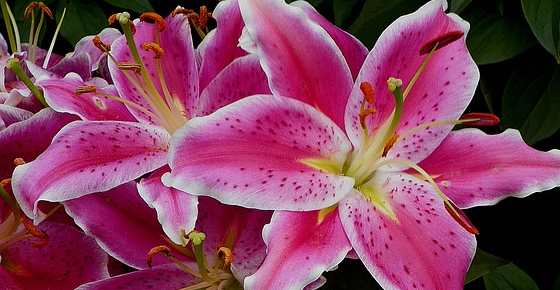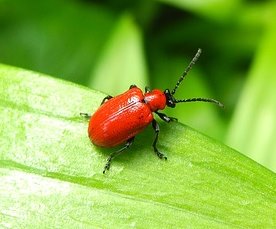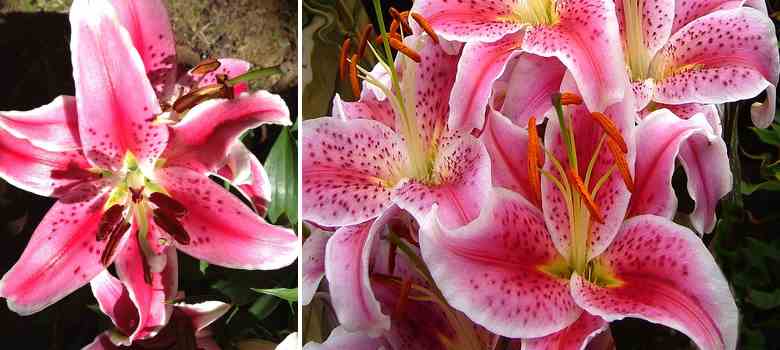Stargazer Lily: Plant Profile, Leaves, Flowers, Care and More

Stargazer lilies are a type of oriental lily hybrid plant that can add stunning colors and fragrant aromas to any garden. Stargazer lily flowers usually bloom from the middle of summer until the end of summer. Their large colorful flowers ranging from light pink to deep crimson colors give off strong scents. Apart from looking stunning, gardeners love to grow Stargazer lily plants because they grow tall and are easy to grow.
Although their flowers look like stars, Stargazer lilies get their name from the fact that the stems grow tall and the flowers look to the heavens. Stargazer lilies thrive well even in poor soil and can grow to a height of 3 ft. (0.9 m). Each stem can grow between 2 and 8 colorful flowers measuring around 6″ (15 cm) in diameter.
In this article, you will learn all about this delightful “star gazing” lily and how to care for it. You will also find out the best tips if you want to grow oriental lilies in your garden.
What is a Stargazer Lily Plant (Oriental Lily)?
The Stargazer lily (Lilium) is a popular hybrid of lily plant similar to Japanese wild red lilies and Asiatic lilies. They are also called “starburst lilies,” “starlight lilies,” or just “Stargazers.”
Stargazer lily flowers grow on the top of tall stems and produce stunning blooms during summer. From many of the oriental lilies, Stargazers are one of the easiest types of lilies to grow in your garden or in containers.
Stargazer lilies grow from bulbs and you can plant them in well-draining sandy soil. However, they will also grow in clay soil.
Stargazer lily leaf type
The Stargazer lily has lance-shaped leaves that alternate up the stem. The lower stargazer lily leaves often fall off as the plant grows taller.
Stargazer plant flowers
Stargazer lily flowers are generally dark pink or crimson in the middle which gradually fades to the edge of the petals. The petal edges and tips are often shades of white to very light pink.
Star lily flowers have large petals that bloom wide open, and some types of Stargazers have petals that curve back on themselves. In the center of the flower are long striking stamens covered in dark yellow pollen.
Some say that double bloom stargazer lily flowers are even more stunning with their multiple rows of bright pink petals.
Another striking feature of Stargazer blooms is the dark crimson speckles that seem to almost cover the entire flower. Just one oriental lily Stargazer stem can produce up to and 8 large vivacious flowers.
Unlike most types of lilies whose flowers droop down, these hybrid lily flowers point up towards the skies. This allows you to take in the beauty of these large pink showy flowers.
When do star lily flowers bloom?
You can expect your oriental lily to bloom in mid-to-late summer. Stargazer lily bulbs that have been planted in the spring should grow and flower usually by July or August.
When they have finished blooming, you should deadhead each flower. Because Stargazers are perennial plants, they will grow and flower year after year if they are in the right conditions.
What do Stargazer lilies smell like?
The scent of oriental lilies and Stargazers are best described as strong fragrant aromas. The pungent sweet exotic scents coming off blooming Stargazers are a delight in any garden.
For some people, though, the pungent smell of Stargazers can be too overpowering. The strong scent from oriental lily varieties can cause headaches, nausea, and even breathing difficulties if the blooms are in enclosed spaces.
Stargazer Lily: The Most Popular Varieties
Stargazer lilies are a variety of hybrid oriental lilies that are easy to grow and resistant to disease. Being a type of oriental lily, Stargazers are more fragrant and taller than Asiatic varieties of lilies.
There are 3 main varieties of Stargazer lilies you can grow in containers or in your garden:
Pink Stargazer is the most common type of “star gazing” lily that has deep pink or red blooms. The Pink Stargazer is a hardy lily hybrid that grows well in partial sun and in direct sunlight.
White Stargazer lilies produce large white stunning lily blooms with petals that curl back, giving off strong fragrances. White Stargazer lilies grow well in full sun and are slightly shorter than the more common Pink Stargazer variety.
Golden Stargazer is a recent newcomer compared to the traditional Pink Stargazer. The blooms of this type of oriental hybrid lily are rich golden colors that are sometimes speckled with red spots. Golden Stargazers bloom in late summer during the months of July and August.
Other types of oriental hybrids that are not Stargazers include varieties such as Black Beauty, Casa Blanca, and Mona Lisa.
How to Grow and Care For Star Lilies
Star lilies are perennial plants that are easy to grow and will flower annually. Stargazers grow well in sandy soil and require regular watering during the summer to keep the soil moist.
After the growing season when the foliage dies back, you can cut the stems back to allow the lily bulbs to regain energy to start growing in the following spring.
Many gardeners like to grow lilies at the back row of a flower bed where they make a beautiful floral backdrop. Lilies look best when planted together to make their blooms even more eye-catching.
Planting Stargazer Lilies in Containers
Stargazer lily plants grow well in containers and can create stunning floral showpieces on a balcony, patio, or decking area. With the right care and attention, you can also plant lilies in containers to grow indoors.
To grow Stargazer lilies in containers, you will need a pot about 7” (17 cm) in diameter. Choose soil that is slightly acidic to neutral which drains well. Put your oriental lily bulbs about 6” into the soil and water well.
The best time to plant Stargazer lily bulbs in pots is in the spring. However, you can also plant them at any time during the growing season and you may get blooms by late summer.
Planting Stargazer Lilies in Your Garden
Most gardeners plant these summer-blooming lily hybrids in their garden to make attractive colorful displays. Lilies planted in the garden are also good for attracting butterflies and hummingbirds.
When to Plant Oriental Lilies
The best time to plant Stargazer bulbs in your garden is in early spring so that they have time to start growing and flowering by mid to late-summer.
You will need to plant oriental lily bulbs quite deep and the recommended depth is 6” (15 cm). Plant the bulbs in soil that drains well and has a pH value of between 6.5 and 6.9.
You can also plant Stargazer lily bulbs in the fall. This will allow them to establish a good root system to start growing and blooming by the following summer. During the winter time, you can cover the soil with mulch to help protect the bulbs from freezing conditions.
Remove the mulch in early spring and cover with light organic compost to encourage healthy lily growth.
Where to Plant Stargazer Lily Bulbs?
Stargazer lily plants thrive best when planted in areas of your garden that get plenty of sun.
You should also make sure that “Star gazer” bulbs are planted in soil that drains well but retains moisture. In hot climates, mulching is recommended to help keep moisture in and prevent the soil from drying out.
When choosing the best place in your garden to plant your lily bulbs, choose an area where your tall blooming plants will create a colorful feature.
You can also plant lilies close by each other about a foot apart. This will result in clusters of stunning pink, white or golden blooms in the summertime.
How to Care for Stargazer Lilies
One of the beauties about growing Stargazer oriental lily hybrids is that they require little care throughout the year.
However, here are a few growing tips for oriental lilies to ensure good, healthy growth.
Light requirements for healthy lily plants
Although Stargazer lilies can tolerate partial shade, they need plenty of sunlight to grow to their full height. To help keep lilies flowering all summer, you should also plant companion plants around them to provide shade for their roots.
How to water Stargazer lilies for good growth
You will need to water your Stargazer lilies growing in pots or your garden enough so that the soil is kept moist. Be careful of over-watering as this can cause roots to rot if ground conditions get soggy.
Soil requirements
Lilies are easy to grow even in less than ideal soil conditions. However, to maximize growth potential, make sure soil is slightly on the acidic side and is well-drained. It is also good to have plenty of organic matter worked into the ground.
Fertilizer for oriental lilies
Even though Stargazer plants will grow without much attention, feeding will encourage large, healthy blooms.
The best way to care for your stargazer lilies is to dig in organic compost around your lilies in early spring. This will provide plenty of nutrients for the blooming time throughout the summer and also help keep the soil moist.
If you decide to use a commercial fertilizer, then a 10-10-10 variety which includes equal percentages of nitrogen, phosphorus, and potassium is sufficient. You should fertilize in early spring for best results.
When and How to Prune Stargazer Lilies
Star lilies benefit from yearly pruning to encourage growth and keep the plants healthy.
Because the splendid perennial blooms and double blooms make for stunning floral displays, you may want to cut off the flowers and put in a vase indoors. If you do this, you can cut off the anthers from the stamens that protrude from the middle of the flower. This prevents yellow pollen staining fabrics, carpets, and clothing.
Stargazer lilies will bloom well every year when you deadhead flowers after they have bloomed. Cut the flower stalk where it joins to the stem. Caring for your oriental lily plant this way prevents seed pods from forming and helps the bulbs grow.
You can prune your lily stems near the ground only when the foliage starts to turn brown.
In most climates, lily bulbs survive well throughout the winter and may only require some mulch to protect them from the cold.
How to Transplant Stargazer Lilies
At some point, you may think about transplanting your Stargazer lily plants. Perennial plants such as oriental lilies grow each year and may outgrow their space.
It is just as easy to transplant Stargazer lilies as it is to grow and care for them. Choose an area of your garden behind shorter plants that gets plenty of sun all day.
To transplant your lilies, carefully dig up the lily bulbs. You will notice that mature lilies have smaller bulbs growing around them that you can separate off and use them for propagation. Replant the bulbs where you want your lilies to grow. Mature bulbs should be 5” to 6” (12 – 15 cm) in the ground and the smaller bulbs can be 3” to 4” (7 – 10 cm) deep. Cover the bulbs with soil, water well and place a layer of mulch over the newly-planted lily bulbs.
The best time to transplant Stargazer oriental lilies is after they have stopped blooming at the end of summer.
For the most striking effect, plant your lilies in groups of 3 or more and plant the bulbs around 9” to 12” (22 – 30 cm) apart.
To transplant Stargazer hybrids from their containers to your yard, follow the same instructions for transplanting lilies in your garden.
Diseases that Can Affect Stargazer Lily Plants
Although Stargazer lilies are hardy plants that grow in most sunny climates, there are a few diseases and pests that can affect them.
The Royal Horticultural Society reports that lily fungus can cause brown spots to appear on leaves. If left unchecked, this fungal disease can destroy the whole leaf. If you notice yellowing leaves that have brown spots, you should remove them and destroy them to prevent further infection. (1)
If lily bulbs become infected with fungal disease or viruses, they should be removed and destroyed. To prevent new lilies from becoming infected, don’t plant them in areas affected by fungi or viruses for at least 5 years.
Lily beetles are a type of garden pest that lays eggs on lilies. Larvae then start eating the leaves as they grow. An infestation of lily beetles can stunt the growth of lilies and prevent them from blooming the following year. (2)
You can spot lily beetles by their bright red wing cases and black head. You may also notice that holes appear in your lily leaves due to beetles gorging on the foliage. From early spring, regularly check your lilies for any signs of pest infestation and remove beetle larvae as necessary.

Lily beetle (Lilioceris lilii) is one of the many types of beetles
Some organic or natural pesticides can be helpful in controlling pests that infest your garden.
For example, neem oil natural insecticides can help to repel lily beetles and stop them from damaging your plants.
Also, you can sprinkle diatomaceous earth (DE) around your plants to help eradicate lily beetles and other bugs that attack your plants. Learn more about using diatomaceous earth as a pest control in your garden.
Are Stargazer Lilies Toxic?
Stargazers are not toxic to humans and most pets. However, the journal Veterinary and Human Toxicology reports that Stargazer and other oriental and Asiatic lilies are toxic to cats. (3)
If cats consume plant material from lilies (Lilium), they can experience gastrointestinal upset and even liver failure.
How to Care for Lily Flowers Indoors
Freshly cut Stargazer lily flowers can create a colorful pink, white, or golden display of stunning blooms in any room.
If you want to enjoy beautiful lily flowers in your home, you may cut off the end of the stamen where the pollen is. Removing the pollen will not only help preserve the length of time your cut flowers last but will also prevent pollen stains on fabric.
To remove pollen stains caused by lily flowers, don’t use anything wet, as it is often easier to remove it dry. The best way to get rid of the pollen is to use sticky tape.
Where to Buy Stargazer Lily?
Most good garden centers stock a wide range of lily bulbs that you can plant in the spring to enjoy their blooms in summer. You may also buy lilies in groups of 3 or more growing in containers.
You can also buy Stargazer lily bulbs from most online stores (such as this one). Always check out reviews from previous customers to make sure that bulbs are of good quality and disease-free.
Related articles:

